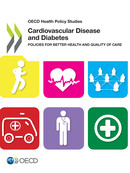Health policies and data
Health Care Quality Indicators - Cardiovascular Disease and Diabetes
Policies for better health system performance
CVD is the number one cause of mortality in most OECD countries and accounts for around a third of all deaths. Many more patients suffer considerable loss in their quality of life due to CVD, particularly through stroke and congestive heart failure. Rising levels of obesity, high cholesterol and blood pressure have led to more people being diagnosed with metabolic syndrome, which in turn is a key risk factor for CVD and diabetes.
Despite its number one ranking, mortality rates have shown considerable improvement over recent decades. On average, OECD member countries have reduced their CVD mortality rate by 42% over the twenty year period to 2005. However, the improvements are not uniform across countries with some countries able to reduce CVD-related mortality by more than 50% and others reducing their rates by less than 30%. These figures raise important questions on why success has varied so much across countries and to what degree do health care systems and policies contribute to this variation?
This OECD project will examine how countries perform in their ability to prevent, manage and treat cardiovascular disease (CVD) and diabetes. The main purpose of this project is to explore the reasons behind the reported differences in the overall health burden due to cardiovascular disease and diabetes. The project will assess performance through countries’ ability to convert health care resources to improved outcomes for patients with CVD or diabetes. It will focus on the role of new and innovative health care policies, access to health care services, quality of care initiatives as well as new technologies on improving CVD and diabetes outcomes.
The project will employ econometric techniques to analyse health system performance using the longitudinal database OECD Health Statistics, supplemented by information from the OECD’s Health Systems Characteristics Survey.
 |
Cardiovascular Disease and Diabetes: Policies for Better Health and Quality of Care17 June 2015 Over the last few decades, mortality from cardiovascular disease (CVD) has dropped faster than mortality from other causes. Despite this great success, prospects for making further progress are threatened by rising levels of obesity and diabetes and the lack of adherence to recommended treatments.. This report examines how countries perform in their ability to prevent, manage and treat cardiovascular disease (CVD) and diabetes. The last 50 years have witnessed remarkable improvements in CVD outcomes. Since 1960, overall CVD mortality rates have fallen by over 60%, but these improvements are not evenly spread across OECD countries, and the rising prevalence of diabetes and obesity are threatening to offset gains. This report examines how OECD countries deliver the programmes and services related to CVD and diabetes. It considers how countries have used available health care resources to reduce the overall burden of CVD and diabetes, and it focuses on the variation in OECD health systems’ ability to convert health care inputs (such as expenditure) into health gains. |
Contact us
Related Documents